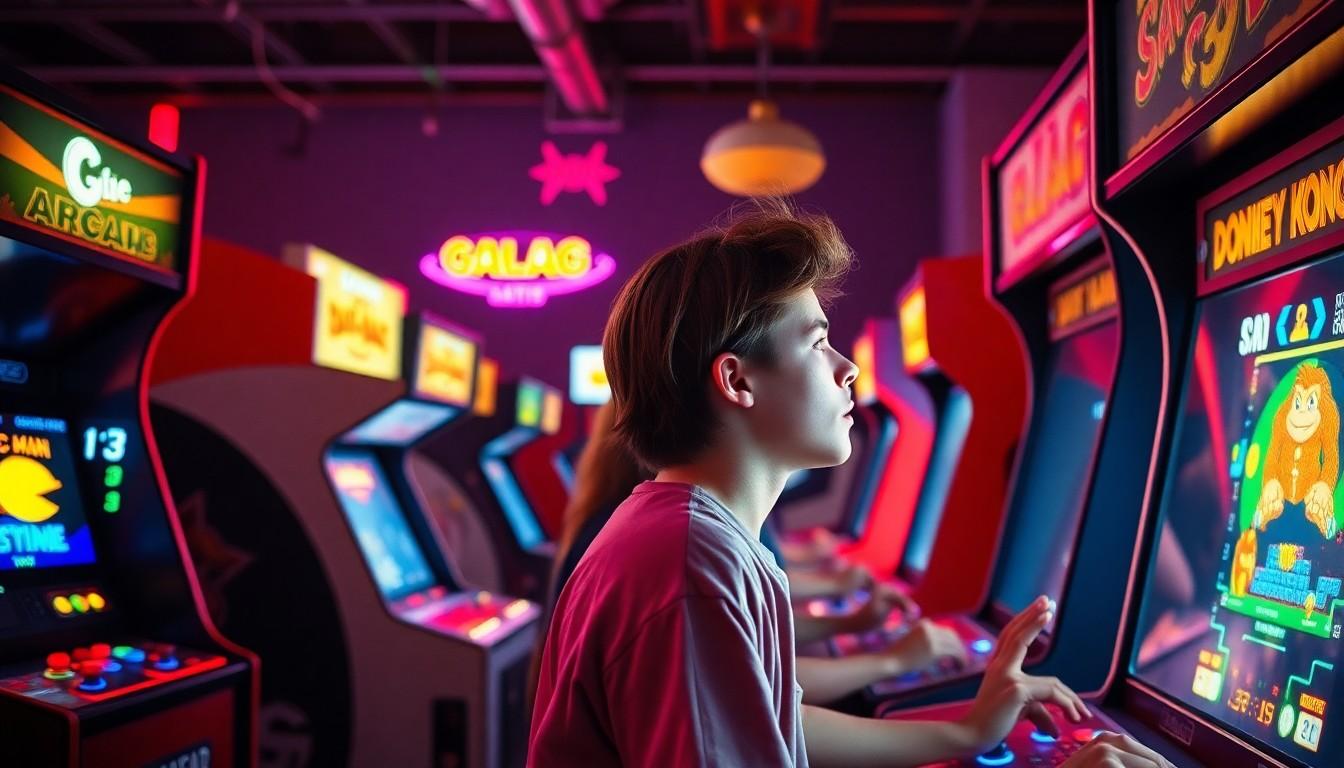Phone:
(701)814-6992
Physical address:
6296 Donnelly Plaza
Ratkeville, Bahamas.

Step back in time to the neon-lit wonderland of the 80s, where arcade games ruled the day and high scores were the ultimate bragging rights. Picture this: the sound of quarters clinking, the smell of popcorn wafting through the air, and the thrill of competing against friends for that coveted top spot on the leaderboard. Those pixelated heroes and villains captured hearts and ignited imaginations like nothing else.
From the adrenaline-pumping action of Pac-Man to the dizzying challenges of Donkey Kong, 80s arcade games weren’t just games—they were a cultural phenomenon. They brought people together, sparked friendships, and occasionally led to some epic meltdowns when that joystick just wouldn’t cooperate. So grab your favorite snack and get ready to relive the glory days of gaming, where every coin dropped was a ticket to adventure and nostalgia.
The 1980s marked a golden era for arcade games. Innovative designs captivated players, drawing them into colorful pixelated worlds. Iconic titles like Pac-Man, Donkey Kong, and Space Invaders dominated the scene, each offering unique gameplay mechanics. Players often competed for high scores, creating a social atmosphere filled with excitement.
Gameplay mechanics varied significantly among titles. Pac-Man introduced maze navigation and power pellets, while Donkey Kong presented platform jumping and obstacle dodging. Space Invaders required players to strategize against wave after wave of aliens, pushing their skills to the limit.
Popularity surged as arcades flourished in malls and pizza parlors, becoming communal hubs for gaming enthusiasts. Players formed friendships, bonding over shared experiences and rivalries. With bright lights and distinct sound effects, the ambiance of an arcade was unforgettable, contributing to the emotional connection players felt toward these games.
Manufacturers invested heavily in arcade technology, leading to rapid advancements. Graphics improved with each release, providing immersive experiences that kept players engaged. The rise of competitive gaming showcased the league play aspect, further enhancing community interaction.
Cultural impact extended beyond the gaming world, influencing music, fashion, and entertainment. Merchandising followed suit, with characters from games appearing in various media. This era birthed a legacy that continues to inspire modern gaming communities.
80’s arcade games represented a significant shift in entertainment, encouraging social interaction while shaping a generation’s love for gaming.

The 1980s featured a lineup of iconic arcade games that shaped the gaming landscape and captured the hearts of players.
Pac-Man emerged in 1980, captivating players with its unique maze-navigation gameplay. Players controlled Pac-Man, maneuvering through a maze while consuming pellets and avoiding ghosts. Cleverly designed mazes created strategic gameplay experiences, making each level exhilarating. The character’s popularity led to merchandise, cartoons, and even a hit song. In 1982, Pac-Man became the first video game character to be widely recognized, solidifying its status as a cultural icon. High score competitions drove players to improve skills and fostered social interactions among friends, creating a vibrant arcade atmosphere.
Released in 1981, Donkey Kong introduced players to the dynamic world of platform gaming. Players assumed the role of Mario, tasked with rescuing a damsel in distress from the clutches of the giant ape, Donkey Kong. Each level presented unique challenges, including barrels and moving platforms. The game’s innovative mechanics paved the way for future platformers. Donkey Kong also marked the debut of Mario, a character who would soon become a cornerstone of the gaming industry. Its release spurred a series of sequels and adaptations, cementing its legacy in video game history.
Galaga hit arcades in 1981, capturing the attention of shooter game enthusiasts. Players piloted a spaceship, engaging waves of alien enemies in captivating aerial battles. The game’s strategic elements included capturing enemy ships and launching powerful attacks. Galaga’s colorful graphics and engaging sound effects enhanced the immersive experience. Players aimed to achieve high scores while navigating increasingly challenging levels. The game fostered a competitive spirit, as friends challenged each other for supremacy at arcade machines. Its lasting popularity ensured Galaga remained a staple in arcade lineups for years to come.
The 80’s arcade scene profoundly shaped gaming culture. Players engaged in social interactions that transcended mere competition.
Arcades served as community gathering spots, where friendships flourished. Games like Pac-Man sparked cooperative strategies among friends, enhancing the social experience. Players often exchanged tips on navigating mazes or defeating levels. High score challenges ignited rivalries, creating memorable moments that lingered long after the game ended. Gathering around arcade machines created bonds, turning gaming into a shared adventure. These shared experiences fostered a sense of belonging within the gaming community.
Technological breakthroughs revolutionized arcade gaming during the 80s. Improved graphics and sound design captivated players, elevating their immersion. Games such as Donkey Kong showcased advanced platform mechanics, setting new industry standards. The introduction of microprocessors enabled more complex gameplay, enhancing player engagement. Innovations like raster graphics brought vibrant colors to game worlds, attracting attention in crowded arcades. This technological evolution laid the groundwork for future gaming developments, influencing how games are designed and experienced today.
The arcade scene experienced significant changes from its peak during the 80s to a notable decline. Factors such as the rise of home gaming consoles increasingly drew players away from arcade machines.
Increased access to home gaming options drastically reduced foot traffic in arcades. Popular consoles like the NES and Sega Genesis offered convenience and a diverse game library at a fraction of the cost. Changing entertainment habits shifted focus from communal experiences to solitary gaming in the comfort of home. Meanwhile, the emergence of personal computers provided additional alternatives for gamers seeking engaging experiences. Ultimately, arcade foot traffic dwindled, leading to the closure of many beloved arcade venues.
The 2000s marked a notable revival for arcade games driven by nostalgia. Many earlier titles gained popularity through retro-themed bars and dedicated gaming events, sparking interest in vintage gaming. New arcade chains emerged, blending classic games with modern innovations to attract a younger audience. Moreover, the rise of indie game development led to fresh interpretations of beloved arcade mechanics, reigniting passion for the genre. Collectively, these factors helped reestablish arcade games as exciting entertainment options and drew gamers from various generations back to these iconic venues.
The legacy of 80’s arcade games continues to resonate in today’s gaming culture. Those vibrant arcades not only provided entertainment but also fostered friendships and community spirit. The innovative gameplay and iconic titles laid the foundation for future gaming advancements.
As nostalgia fuels a resurgence of interest in retro games, new generations are discovering the joy of classic arcade experiences. Whether through themed bars or indie game adaptations, the spirit of the arcade lives on. The impact of this golden era is undeniable, shaping the way players connect and engage with games today.